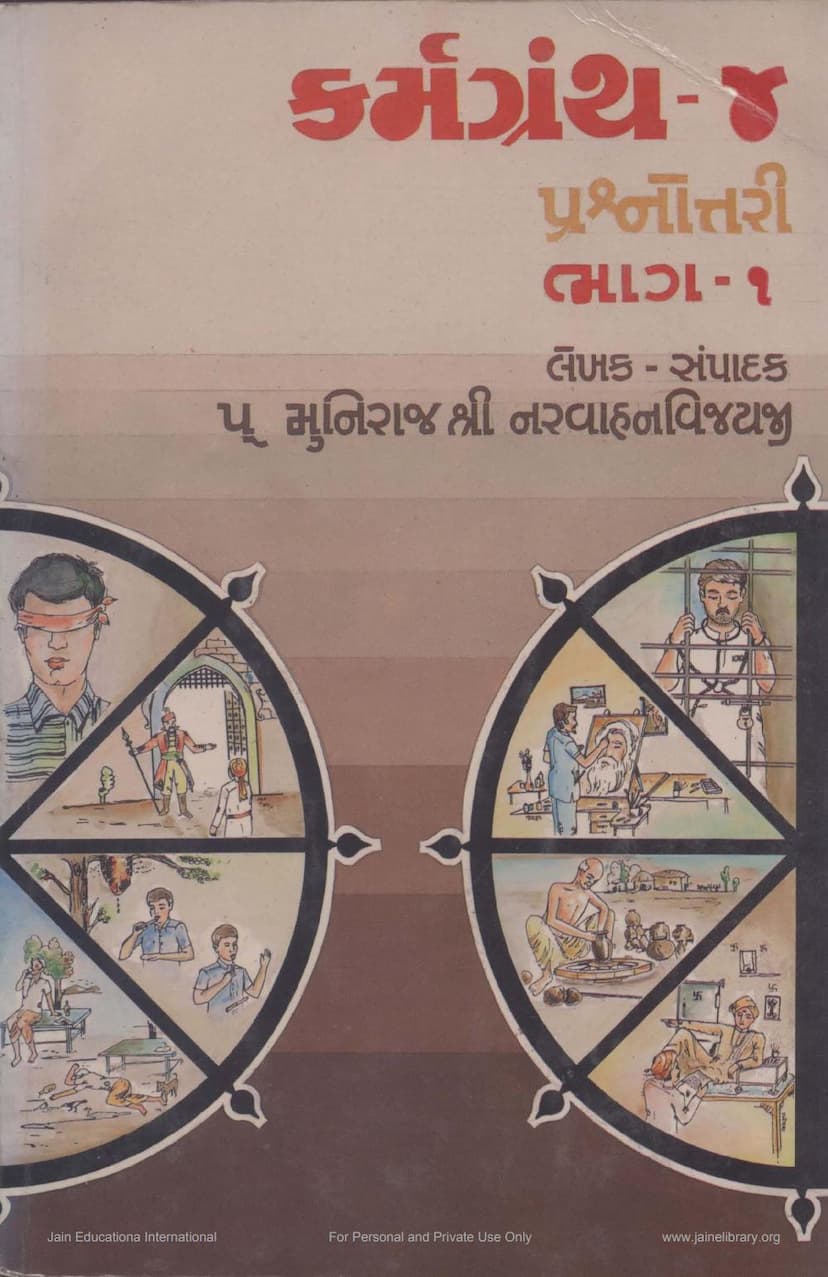Karmgranth 04 By 01 Prashnottari
Added to library: September 2, 2025

Summary
Here is a comprehensive summary of the Jain text "Karmgranth 04 by 01 Prashnottari" by Narvahanvijay, based on the provided pages:
Book Title: Karmgranth 04 Prashnottari (Part 1) Author/Editor: Pujya Muni Shri Narvahan Vijayji M.S.A. Publisher: Shri Dharmik Bandhu, Mumbai
Overall Purpose and Content: This book is a question-and-answer (Prashnottari) compilation that explains the complex principles of Karma (Karm Siddhanta) according to Jain philosophy. It aims to make these profound concepts accessible to a wider audience, particularly those who may not have direct access to or expertise in studying the original Agam literature. The text focuses specifically on the teachings contained within the fourth major Karmgrantha, known as "Padshiti" (which has 86 verses, though the book is Part 1 of the Prashnottari series on this topic).
Key Themes and Structure:
-
The Nature of Karma: The text begins by emphasizing that Karma is the fundamental element that obscures the soul's true nature and causes its cyclical existence in the world (samsara). It explains how karma binds the soul, leading to the loss of its innate infinite knowledge, perception, happiness, and virtuous conduct, resulting in the adoption of new names and forms, the cycle of birth and death, and states of suffering.
-
The Importance of Understanding Karma: To overcome the bondage of karma, it is crucial to understand its nature, principles, and mechanisms. The book highlights that Jain philosophy presents a highly detailed, systematic, and mathematically precise explanation of karma, stemming from the teachings of omniscient beings.
-
Sources of Karmic Knowledge: The summary details various Jain scriptures where karmic principles are discussed, including:
- Agamas: Dashavaikalik, Uttaradhyayan, Sthananga, Samvayanga, Bhagwati Sutra, etc.
- Commentaries and Niryuktis: Aavashyak Niryukti, Visheshavashyak Bhashya, etc.
- Specific Karmagranthas: It references earlier works like the Bandhashatak and Karma Prakarana Sangrahni by Acharya Shivashuri, and later influential works like the Panch Karmagranthas by Acharya Devendrasurishwarji, which form the basis for much of the current understanding.
-
Detailed Breakdown of the Five Karmagranthas (as per Acharya Devendrasurishwarji): The book outlines the content of the five primary Karmagranthas:
- Karma Vipak: Describes the primary karmas and their 158 subdivisions and their consequences.
- Karma Stav: Explains the types of karmic bondage, fruition, and status (Satta) for souls at each of the fourteen stages of spiritual development (Gunasthana).
- Bandh Swamitva: Details which of the 120 karma prakritis can be bound in various "Margana Sthanas" (modes of investigation concerning soul's condition), such as Gati (states of existence), Indriya (senses), Kaya (body), Yoga, Ved, Kashay, etc.
- Padshiti: Discusses various aspects of karma through ten "dwaras" (gates or categories), including Jiv Sthanak (soul states), Margana Sthanak, Gunasthanak, Yog, Upayog, Leshya, Bandh (bondage), Uday (fruition), Udherna (hastening fruition), and Satta (status), as well as concepts like quantities (Sankhyata, Asankhyata, Ananta). This book, Karmgranth 04, is specifically a Prashnottari on the Padshiti principles.
- Shatak: Covers 26 topics related to karma, including types of bondage (Dhruva Bandhi, Adhruva Bandhi), states of fruition (Ashrudaya, Adhrudaya), states of status (Dhruva Satta, Adhruva Satta), Ghathi and Aghati karmas, Punya and Pap karmas, changes in karma (Paravartman, Aparavartman), karma based on what they affect (Kshetra Vipaki, Jiva Vipaki, etc.), and the four types of bondage (Prakriti, Sthiti, Ras, Pradesh), including the owners of these bondages, and the paths of Upasham Shreni and Kshepak Shreni.
-
Prashnottari Format (Q&A): The core of this volume (Karmgranth 04, Part 1) is structured as a dialogue between a questioner and an answerer. It systematically covers the topics outlined in the Padshiti Karmagrantha in a question-and-answer format.
-
Detailed Content (Examples from the Q&A): The summary details the initial questions and answers, covering:
- Types of Namaskar: Four types of respectful salutations.
- The Ten Categories of Padshiti: Introduces the ten main areas of discussion: Jiv Sthanak (14 types), Margana Sthanak (62 types), Gunasthanak (14 types), Upayog (12 types), Yog (15 types), Leshya (6 types), Bandh Hetu (bondage causes), Alpabahutva (relative quantities), Bhavas (states), and Sankhyata-Asankhyata-Ananta (quantities).
- Classification of Souls (Jiva): Explains the 14 Jiva Sthanas, from Sukshma Aparayapta Ekendriya to Sanni Pపంచendriya Paryapta.
- Stages of Conduct (Gunasthanak): Lists and briefly explains the 14 Gunasthana.
- Activities of the Soul (Yog and Upayog): Defines and categorizes Yog (body-speech-mind activity) and Upayog (consciousness activity).
- Karmic Qualities (Leshyas): Explains the six Leshyas (colorations of the soul due to karma).
- Bondage, Fruition, and Status: Discusses Bandh (bondage), Uday (fruition), Udherna (hastening of fruition), and Satta (status) of karmas.
- Alpabahutva: Explains the concept of relative quantities and how different categories of souls relate to various states.
- The Interrelationship of Categories: Provides detailed explanations for the sequence in which these categories are discussed (e.g., why Jiv Sthanak comes before Margana Sthanak).
-
Authorship and Spiritual Lineage: The author, Muni Shri Narvahan Vijayji, is presented as a dedicated and knowledgeable disciple of Acharya Shri Himatt Vijay Ramchandrasurishwarji Maharaj. His deep study and internalization of the Karmic texts are highlighted, emphasizing his commitment to disseminating this knowledge.
-
Acknowledgement of Contributors: The preface acknowledges the support and contributions of various individuals and organizations, including patrons and reviewers, in bringing this publication to fruition.
In essence, "Karmgranth 04 Prashnottari (Part 1)" serves as a structured and accessible guide to the intricate science of karma in Jainism, drawing from foundational scriptures and presented in a clear question-and-answer format to facilitate understanding for a broad readership.